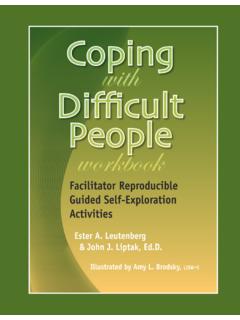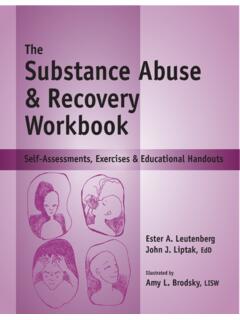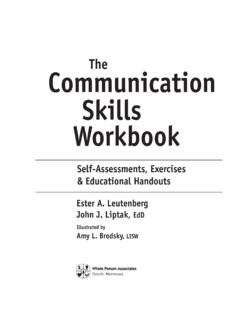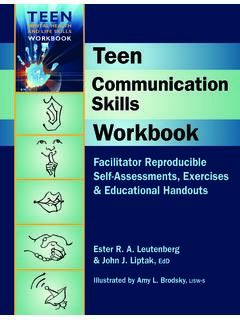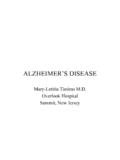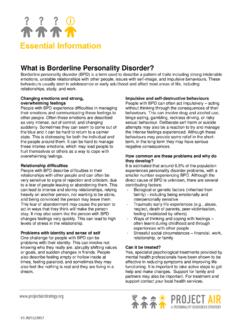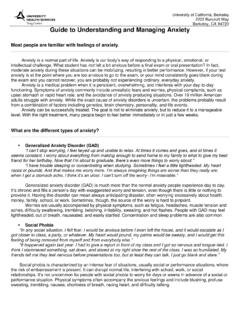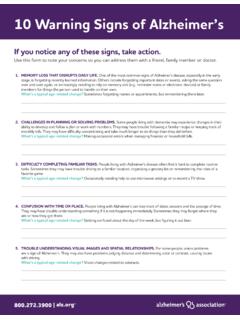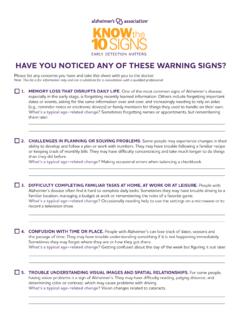Transcription of Managing Unwanted Thoughts, Feelings and Actions …
1 Managing Unwanted Thoughts, Feelings and Actions WorkbookEster R. A. Leutenbergand John J. Liptak, EdDA Toolbox of RepRoducible AssessmenTs and AcTiviTies for FAciliTAToRsErasing thEof MEntal illnEss through awarEnEssManagingUnwanted Thoughts, Feelings and ActionsWorkbook A TOOLBOX of REPRODUCIBLE ASSESSMENTS and ACTIVITIES for FacilitatorsEster Leutenbergand John J. Liptak, EdDDuluth, Minnesota101 W. 2nd St., Suite 203 Duluth, MN Unwanted Thoughts, Feelings and Actions WorkbookA Toolbox of Reproducible Assessments and Activities for 2015 by Ester Leutenberg and John Liptak. All rights reserved. Except for short excerpts for review purposes and materials in the activities and handouts sections, no part of this workbook may be reproduced or transmitted in any form by any means, electronic or mechanical without permission in writing from the publisher.
2 Activities and handouts are meant to be efforts have been made to ensure accuracy of the information contained in this book as of the date published. The author(s) and the publisher expressly disclaim responsibility for any adverse effects arising from the use or application of the information contained in the United States of America10 9 8 7 6 5 4 3 2 1 Editorial Director: Carlene Sippola Art Director: Joy Morgan DeyAssistant Art Director: Mathew PawlakLibrary of Congress Control Number: 2014957801 ISBN: 978-157025-326-3 Introduction 2015 Whole Person AssociAtes, 101 W. 2nd St., Suite 203, Duluth MN 55802 800-247-6789 iiiUsing the Managing Unwanted Thoughts, Feelings and Actions WorkbookPeople who encounter Unwanted thoughts, Feelings and Actions face frightening experiences.
3 They may have a difficult time distinguishing between what is real and what is not real. They usually regret what they thought and felt, and/or how they acted. They find that often this interferes with their work, school, family relationships, and interactions with friends and people in their community. Unwanted thoughts, Feelings and Actions can cause confusion, be difficult to deal with, and disrupt any health issues contribute to Unwanted thoughts, Feelings and Actions . When adults experience these symptoms, they are typically challenged by being and remaining in touch with reality. They have difficulty coping with the stressors and demands of their daily lives. How Do Unwanted Thoughts, Feelings and Actions Issues Manifest Themselves?Because there are so many bizarre ways these Feelings can manifest themselves, disturbances can be very difficult to identify and manage.
4 It is critical to be aware of, to understand, and to acknowledge how symptoms are commonly experienced. Although most or all symptoms to do not have to be present, those that are present will typically cause significant distress and/or impairment in daily functioning. Listed below are some possible symptoms:Our goal for this workbook is NOT to diagnose mental illness, or even for the facilitator to make such a diagnosis from this workbook s content. Our goal is to touch on some of the symptoms and possibilities, create realizations, and provide coping methods which will help people to go forward and perhaps consider the possibility of the need for medications and therapy. Our goal is also to help participants recognize that other people have the same issues, that no shame is connected to them, and mental health issues of any degree are not to be stigmatized nor should anyone feel like a victim of stereotyping.
5 In this workbook , we are using the phrase mental health issues to include all types of Unwanted thoughts, Feelings and Actions issues, from having a few problems to a serious mental illness. Agitation Cold manner Confused thoughts Dangerous Actions Delusions Detached from others Difficulties in the workplace Disinterest in maintaining personal hygiene Disorganized speech Feelings of entrapment Flat affect Forgetfulness Hallucinations Inability to understand and accept reality Inability to communicate well with others Inability to express emotions Inability to make good decisions and judgments Inability to think clearly and rationally Inappropriate behavior Incoherent speech Increased drug/alcohol use Intense anxiety Loss of appetite Loss of interest in everyday activities Loss of touch with reality Mood swings Problems in school Problems maintaining relationships Rigid Actions
6 Strange Actions Suicidal thoughts Unusual movements Withdrawal from others sociallyManaging Unwanted Thoughts, Feelings and Actionsiv 2015 Whole Person AssociAtes, 101 W. 2nd St., Suite 203, Duluth MN 55802 800-247-6789 Sources of Unwanted Thoughts, Feelings and Actions Issues As with many different types of psychological problems, the origin of these Unwanted thoughts, Feelings and Actions issues are difficult to pinpoint. Because of their complex nature, these issues are often brought on by one or a variety of these sources:Genetics and BiologyPsychotic disturbances often run in families and thus researchers believe that they are inherited, but that is not the only cause. A complete medical and psychological history should be collected by a medical professional to identify family members who may also have experienced disturbances with Unwanted thoughts, Feelings and Actions .
7 Brain ChemistryThe structure and functioning of the brain has been shown to have an effect on the incidence of psychotic disturbances. Chemicals in the brain (neurotransmitters) that communicate between neurons, also seem to play a role. In addition, the structure of the brain found in healthy individuals is different from that of people who experience disturbances with Unwanted thoughts, Feelings and Actions . An examination to explore the structure and functioning of the brain should be conducted by a medical EventsAn inability to cope with major stressors can be a factor in disturbances in thoughts, Feelings and Actions . Some of the major stressors might include traumatic shock or abuse. An examination of the person s life events that may be causing Unwanted thoughts, Feelings and Actions needs to be conducted by a medical professional.
8 Medical ConditionsDisturbances with Unwanted thoughts, Feelings and Actions are more likely to occur in people with poor medical health in general, or those who suffer from an existing psychological problem. A medical history can reveal conditions that might induce problems in thoughts, Feelings and Actions , and should be examined by a medical professional. SubstancesA history of problematic drinking, tobacco, marijuana or other drug use has been associated with the development of disturbances with Unwanted thoughts, Feelings and Actions . A history of a person s drug, tobacco and alcohol use should be examined by a medical 2015 Whole Person AssociAtes, 101 W. 2nd St., Suite 203, Duluth MN 55802 800-247-6789 vHow the Managing Unwanted Thoughts, Feelingsand Actions workbook Can HelpPeople experience many different types of problems related to Unwanted thoughts, Feelings and Actions .
9 The assessments and activities in this workbook are designed to provide facilitators with a wide variety of tools to use in helping people manage their lives more effectively. Many choices for self-exploration are provided for facilitators to determine which tools best suit the unique needs of their clients. The purpose of this workbook is to provide a user-friendly guide to short-term assessments and activities to help people manage their Unwanted thoughts, Feelings and Actions , and experience a greater sense of well-being. In addition, this workbook is designed to help provide facilitators and participants with tools and information needed to overcome the stigma attached to issues of Unwanted thoughts, Feelings and order to help participants deal successfully with Unwanted thoughts, Feelings and action issues, facilitators need to have a variety of assessments and activities to help their participants open-up and begin to feel they can manage the symptoms of their Unwanted thoughts, Feelings and Actions and realize that they are not alone.
10 The Managing Unwanted Thoughts, Feelings and Actions workbook provides assessments and self-guided activities to help participants understand the intensity of their issues and how they can lead a more effective to Worry?Disturbances in Unwanted thoughts, Feelings and Actions are difficult to manage because they blur the line between what is real and what is not real. The good news is that people can develop the skills needed to manage the symptoms and progress forward to begin enjoying life more. Unwanted thoughts, Feelings and Actions that accompany many of the mental health issues that people deal with daily can be a very frightening way to live. People who experience these issues over time are at risk of having a serious mental illness and need to seek a medical professional. Suicide Warning!
